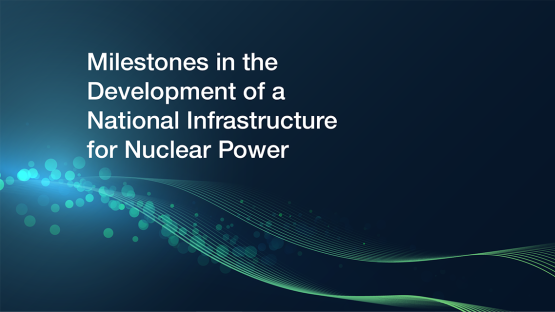A new version of the IAEA publication ‘Milestones in the Development of a National Infrastructure for Nuclear Power’ is now published and has been revised to address issues related to small modular reactors.
The updated document, the IAEA's foundational guidance on how to prepare to introduce a nuclear power programme or expand an existing nuclear power programme, includes an annex outlining aspects specific to the deployment of small modular reactors (SMRs) and highlights the recent experience of several countries which have completed or made major progress in all three phases with other reactor types as defined by the IAEA’s Milestones Approach.
The release of this second revision is timely as nuclear power has momentum and is increasingly acknowledged as a necessary element of the net zero transition. A major increase in nuclear power deployments is needed for the world to hit net zero carbon goals by 2050, meaning it must both scale up in existing markets and expand to new ones.
This new edition of the milestones publication, originally produced in 2007 and revised in 2015, is provided within the context of the IAEA’s other guidance and materials relevant to nuclear power development in areas including nuclear safety, security and safeguards. This publication also incorporates lessons learned from recent Integrated Nuclear Infrastructure Review (INIR) missions to countries introducing or expanding nuclear power programmes.
While most new capacity is still expected to come in the form of large water cooled reactors in the coming years, there is a growing opportunity for SMRs to play an important role in reducing emissions and supporting sustainable prosperity. Designed to produce typically no more 300 MW(e), SMRs could be ideal for deployment in remote areas as well as regions with smaller electric grids. SMRs will feature modular designs, enabling systems and components to be factory-assembled and transported as a unit to a location for installation. This could help reduce the time required for construction. And with new end users such as data centres considering nuclear power to meet their growing electricity needs and a range of industrial applications requiring decarbonization, there is no shortage of potential applications. SMRs may be able to be deployed faster and play a larger role depending on how quickly they are licensed and achieve commercial readiness.
“As the nuclear power landscape continues to evolve, so too must the assistance we provide. This latest update of the IAEA milestones guidance comes at a pivotal moment when an increasing number of countries are considering nuclear power for their energy mix to achieve their net zero pledges,” said Aline des Cloizeaux, Director of the IAEA’s Division of Nuclear Power. “It is clear that SMRs will be a vital component of the clean energy transition, and we must ensure that countries interested in this technology have a solid understanding of what is needed to successfully implement SMR projects.”
SMRs are in many ways very similar to their larger counterparts. They comprise many of the same systems and operate according to the same principles that have driven nuclear power reactors for decades. The needs for SMRs are also mostly the same as for traditional reactors, such as strong legal and regulatory frameworks, proactive stakeholder engagement and environmental protection considerations. But due to their unique features, including lower power output and simplified designs, a few of the specific infrastructure requirements may vary.
Some SMRs, particularly those using coolants other than water, may generate new forms of radioactive waste, and so countries planning to deploy SMRs must plan to manage these new waste types. If new fuel types are employed, it will be important to establish a supply chain to secure the consistent availability of fuel. And new safeguards approaches may need to be developed to address certain novel design features of SMRs, ensuring that robust nuclear material accountancy and control measures are not hindered.
There are currently around 30 newcomer countries either considering nuclear power or moving forward with plans to construct their first nuclear power plant. Bangladesh, Egypt and Türkiye are constructing their first nuclear power plants and several more countries are expected to build their first plants over the next decade or so.
Argentina, China and Russia have SMRs under construction, with the latter two countries having deployed their first SMRs in 2019 and 2021 respectively. Several newcomer countries, including Estonia, Jordan and Poland, have identified SMRs as part of their future clean energy systems. An INIR mission focused on SMRs was conducted in Estonia last October, and Jordan is examining how SMRs could be used to address its seawater desalination needs after meeting with IAEA experts last August.
The IAEA will host the first International Conference on Small Modular Reactors and their Applications from 21 to 25 October in Vienna. The conference will provide an international forum to take stock of progress and discuss opportunities, challenges and enabling conditions for the accelerated development and deployment of SMRs. All persons wishing to participate in the event must either be designated by an IAEA Member State or should be a member of an organization that has been invited to attend.






